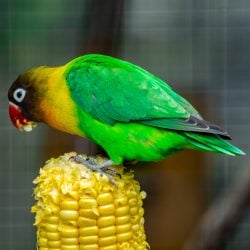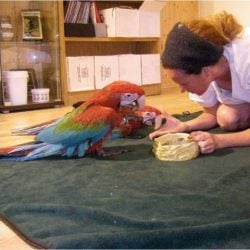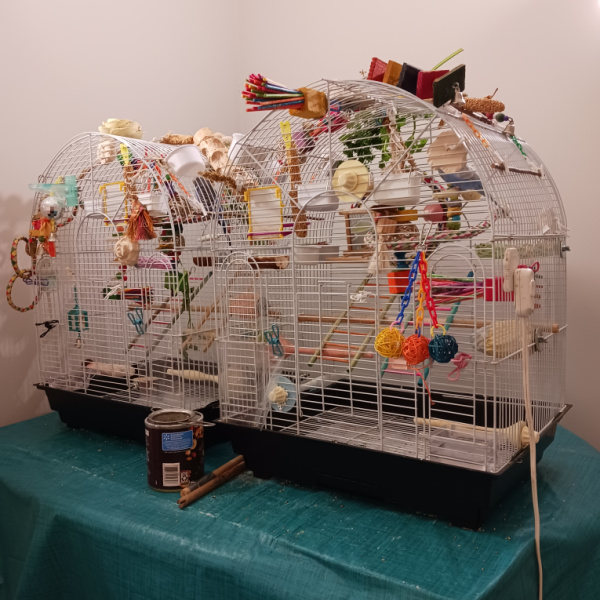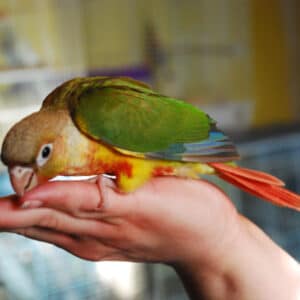Last Updated on by Mitch Rezman
1) I’m assuming that a 32″ wide cage is sufficient. Please correct me if I’m wrong.
Yes, you are correct a 32-inch wide cage is sufficient. That said we believe there is a general misunderstanding of cage sizes in terms of the content found on the Internet. The size cage that a bird needs is really more dependent upon lifestyle both yours and the birds.
If your bird is going to be caged 12 hours a day while you’re at work and/or if you have a busy lifestyle a larger cage would be more humane to allow the bird to move around and stretch his wings. This relates to your lifestyle as you have to make sure you have the room for very large chunk of metal to occupy the space in your home. All cage measurements on our site do not include seed guards. If you’re going to install seed guards you need to add 8 to 10 inches side to side and front to the back of all the cage dimensions.
If your bird is going to be outside the cage the majority of the day and only sleep in the cage a smaller cage would be just fine in the 24 inch wide range.
2) Money is a concern for me, I would love to spend $400 on a quality powder coated white cage rather than $1500 on a similar stainless steel one, however, if you told me even the best quality powder-coated brand-name cage will start to rust and need to be replaced after 5 years of use, then I will consider purchasing a stainless-steel one.
Ironically even stainless steel cages can rust if not properly cared for and there are many grades of stainless steel. A properly powder coated bird cage should provide many many years of service. The mistake that most people make is taking the cage outside and power washing it. The four corner supports of most bird cages are hollow and although they’re powder coated externally there is no coating on the inside of the tubular metal.
Thus with the interior exposed metal having been exposed to a great deal of water a cage will rust from the inside out. This is why we recommend cleaning your cage with a handheld steam cleaner for major cleaning and enzymatic cage cleaning products like poop off for day-to-day use.
3) Which top design do you prefer? Dome? Playtop? or Victorian? I like all three, my wife likes the Victorian because it opens at the top and the design is nice. Please state your reason for one vs. another.
Once again the style of a birdcage top is much to do with your bird’s lifestyle. When you take your bird out of the cage for socialization you have to put it somewhere. Put it on the back of the chair and your expensive side chair becomes kindling.
If you have the room and/or are moving the bird from room to room you may want to consider a play stand. That said with a play top you can take your bird out of the cage and put your bird directly on the top of the cage where the bird can comfortably perch, find food and water, and most importantly a tray to catch droppings so they don’t soil the top of the cage or the items within.
Birds are birds and they usually go to the top of the cage anyway but with a dome or Victorian top if they spend much time up there the top of the bars will get soiled as well as anything else in the cage in the way of a poop trajectory. Providing food and treats is more difficult as well.
Some dome top and Victorian top bird cage models have open tops and what we call drop-down landing doors is in the cage pictured below. Not all Victorian tops open up and some done tops do. Reading the cages details carefully will help you choose the right cage for your bird.
Although the macaw on the left is standing on top of the edge of the door in most cases a perch is inserted between the two open doors to hold it open and provide another perch. If the bird is flighted the landing door serves a valuable purpose in allowing the bird to land on a horizontal surface reducing the possibility of trying to land on the vertical part of the cage and possibly bruising their chest.
4) If I do decide on purchasing a quality power-coated white cage, which brand is considered top-of-the-line?
All of the birdcage brands we carry are Bird safe and considered to be of high quality. Please click on the button below to read a side-by-side comparison of the three major brands that we sell.
5. I’m reading on the internet that I need to purchase a cage with at least 1″ bar spacing. Is 3/4″ ok? I am assuming not to purchase a 5/8″ bar-spaced cage.
Much like birdcage size, the bar spacing ultimately has to be determined by the bird going into it. The thought behind bar spacing is that you don’t want the bars to be wide enough for your bird to stick its head through and possibly get caught. I’m quick to remind people that for this to happen because birds have eyes on the size of their heads, it’s rare for birds to be so motivated that they scrape their eyeballs while trying to force its head between two bars.
A topic that isn’t covered a lot is the additional gaps throughout the cage that can pose potential danger such as where feeder doors meet the cage or the spaces where the bottom grills and refuse trays are inserted into the cage.
5/8″ of an inch bar spacing is a little small for an Eclectus. Three-quarters of an inch to an inch and even an inch and a quarter will be fine for an Eclectus. Two other things to consider when evaluating bar spacing are how was the space being measured? From “between” the two bars or from the “center of the two bars to the next center”? This is a little more critical for smaller birds than for larger birds.
The other issue is with narrower bar spacing you need more bars which will drive up the manufacturing cost of the cage due to the additional metal and weight.
We are currently deploying buttons in all of our cage listings to indicate our best guess for the most appropriate size birds for every cage we have on the site You will see these buttons on about half the listings now the balance of listings should be completed by the end of October to help in better selecting the appropriate cage for your bird
Congratulations on the impending arrival of your new bird. Eclectus parrots make wonderful family pets.
Author Profile
Latest entries
 PigeonsJune 20, 2025How Do Parrots Thrive in Cities Outside Their Native Habitats?
PigeonsJune 20, 2025How Do Parrots Thrive in Cities Outside Their Native Habitats? Feeding Exotic BirdsJune 20, 2025Is Corn On the Cob Safe for Pet Birds?
Feeding Exotic BirdsJune 20, 2025Is Corn On the Cob Safe for Pet Birds? Bird & Parrot AnatomyJune 19, 2025Would You Like a Comprehensive Guide for Training Your Bird?
Bird & Parrot AnatomyJune 19, 2025Would You Like a Comprehensive Guide for Training Your Bird? Feeding Exotic BirdsJune 19, 2025Here Are Three (Video) Strategies to Help Your Bird Forage
Feeding Exotic BirdsJune 19, 2025Here Are Three (Video) Strategies to Help Your Bird Forage




